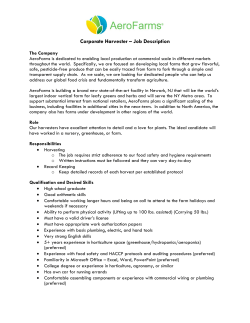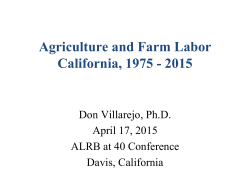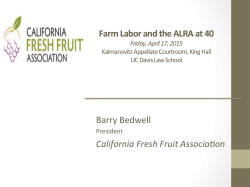
ALRB at 40 - the University of California, Davis
ALRB at 40 Don Villarejo April 17, 2015 Phil has provided a helpful overview of both changes in production and the major shift of the work of the ALRB and the General Counsel over the course of the last four decades. My perspective on the expansion of labor-intensive crop production is best summarized by measuring the physical volume of fruit and vegetable production – which is independent of commodity prices – that has nearly doubled since 1975, from about 21 million tons per year to about 40 million tons per year by 2012. If that were California-produced autos or refrigerators, it would surely be front-page news, but since it is lettuce, melons, tree fruit, grapes and strawberries, among many other commodities, it merits far less attention. Susan’s excellent description of the crop workforce should remind us that the National Agricultural Workers Survey, initiated under Rick Mines’ leadership, is an extraordinary resource that didn’t exist in 1975. The only substantial survey of farm labor in California that pre-dates the ALRA was the 1965 survey led by Dr. Cheryl Peterson, supported by the California legislature. That survey found 30% of our state’s hired farm workers were migratory, and 6% were seasonal workers, that is, entirely out of the labor force, not employed or seeking work, such as students or housewives, for at least forty weeks of the year, per the Department of Labor’s definition of this term. I just want to comment that our terminology has significantly eroded to a point where the term seasonal workers today is applied even to all of those workers are in the labor force year-round, but whose jobs in agriculture are seasonal in nature. As the NAWS has demonstrated, a great many workers seek non-farm jobs, if they can find them, when not working on farms, and some survive on unemployment compensation benefits because they remain in the labor force. Rick Mines’ research showed that all but a relative handful of California crop workers are actually in the labor force year-round despite lacing employment for a significant portion of the year. I think the more accurate term we should be using would be seasonally employed farm workers. The comments from Tom and Diane remind us that, from the perspective of both employers and workers, no policy task is more urgent today than fixing our broken immigration laws and regulations. It appears that extending DACA to more persons who currently lack employment authorization is the only short-term possibility. I do have a few comments I’d like to add to the discussion. The changes in temporal farm employment since 1975 are simple: instead of a peak of employment in September of each year, we now have a six-month “peak period” of farm employment that extends from May through September, thanks to both earlier and later varieties, nearly year-round harvesting of some annual crops such as strawberries, a major increase in winter pruning labor owing to the huge expansion of tree and vine plantings, and other factors. Slide 2. Note peak in September during 1975-77, vs. six-month “peak period” from May through September during 2011-13. Also, in all but September, employment in each month was greater in recent years as compared with the earlier time frame. Overall, there have been substantial changes in agricultural employment between 1975 and the present: self-employed workers (farmers and ranchers, including unpaid family workers) have sharply declined. Direct hire farm labor employment has declined somewhat, while labor contractor employment has dramatically increased, as have other types of agricultural service employment. Slide 3. Distinguish self-employment (farmers, ranchers and unpaid family workers) from hired worker employment. The biggest increased have been in FLC and other services. Next, we examine what transpired among farm employers with differing payroll sizes during this same time frame. Overall, the number of employers of farm labor declined by 50% between 1975 and 2013. While the number of farm and ranch employers with 500 or more employees during September grew by half between 1979 and 2013, increasing from 28 in 1979 to 41 in 2013, the number of FLCs with 500 or more employees quadrupled, increasing from just 21 in 1979 to 93 in 2013. Again, note the reversal: in 1979, the number of farm operators with 500 or more employees was one-third greater than the corresponding number of FLCs of that size. But in 2013, the number of FLCs with 500 or more employees in September was twice as large as the number of farm operators of corresponding size. Slide 4. The dramatic increase in the total number of persons employed by farmers of agricultural service business, mostly FLCS, with at least 500 workers during September of 1979, more than tripled in September 2013, increasing from 38,000 to more than 140,000. The entire distribution of employment, by employer size, shifted from smaller employers to much larger ones. What’s important in the present context is that labor contactors, as distinct from farm management businesses, are not recognized for collective bargaining purposes under the ALRA. Thus, the employment sector in agriculture that has experienced the most rapid growth since 1975 does not exist, as far as the law is concerned. Persons employed by a labor contactor will typically know the name of the contractor, but may be entirely unaware of the name of farm operation of the place where they are working. There is evidence that wage rates have not improved for direct-hire field and livestock workers since 1974. In 1974, farmers and ranchers reported to the USDA Farm Labor Survey that the average wage rate for direct-hire field & livestock workers (production workers) was $2.60 per hour. In 2014 dollars, that’s $13.50 per hour. But California’s farmers and ranchers interviewed in 2014 reported the average wage rate for direct-hire field and livestock workers in that year was just $11.33. Another measure of farm labor wage rates compares them with wage rates for production workers in other industries, such as jobs in California’s manufacturing industry. That ratio, in both 1974 and 2014, was identical: 54.2%, meaning that farm workers have made no progress in improving their earnings relative to other production workers in the state. Slide 5. Annual average wage rates for direct-hire farm workers in 1974 and 2014. Ratio of direct-hire farm labor wage rates to manufacturing workers in 1974 and 2014 are unchanged. Poverty remains unacceptably prevalent among California’s hired farm workers. Slide 8. Poverty Amidst Plenty. Tulare County poverty and worker reliance on SNAP and food pantries. It is obvious that the economic status of a very large portion of California’s farm labor workforce has not improved since 1975. Moreover, the status of the agricultural industry, despite its obvious success in the face is many obstacles, has declined. The latest data indicate farm cash returns from the sale of agricultural commodities has slid to just 2% of the state’s GDP, down sharply from the corresponding measure in 1975. And farm employment is now a much smaller share of the state total than was the case in 1975. I think it is time for consider a fundamentally different paradigm to look for improved prospects for farm labor in California. Consumers and other parties, such as environmental advocacy organizations, have become significant players in agricultural and farm labor issues. A few examples: • A new form of worker collective action has succeeded in forcing food marketing organizations to take responsibility for improving wages and working conditions of farm labor. Pioneered by the Baldemar Velasquez and the Farm Labor Organizing Committee in the Midwest and East Coast, another form has emerged in recent years – encounter at Taco Bell in Tucson 12 years ago – exemplified by the Coalition of Immokalee Workers. The CIW succeeded in persuading 11 major supermarket chains and fast-food businesses, such as McDonald’s, Burger King, Subway and WalMart, to underwrite increases in farm wages, and other changes in employment relations, by mobilizing consumers – Note that issues associated with secondary boycotts in labor relations disputes are not a concern; • Just in the past month, thousands of farm laborers employed in Mexico’s produce export business in Baja California participated in a multi-week strike starting on March 17 – their main leader was Fidel Sanchez, a veteran of CIW organizing in the U.S. They mounted the same tactic as CIW, i.e., seeking to persuade major fast-food chains and supermarkets to support their demands. Their petition has already gained more than 20,000 signatures, and is continuing to gather supporters. Some grower-packer-shippers based in our state are already feeling the pressure. The issues facing California agriculture, and its workers, now include: • development of adequate irrigation supplies in a political environment in which urban residential use and environmental concerns are increasingly • • • • taking precedence over agricultural needs (CVPI, groundwater management, SWRCB policy); nitrate contamination of groundwater basins in both the Salinas Valley and the Tulare Lake Basin, for which seeking a resolution of this problem has already brought to the forefront parties who are not related to agriculture in any way; failure of policy makers to agree on significant immigration reform and an important Congressional leader representing a leading agricultural area of the state ignoring pleas from farm employers as well as from workers; an emerging impasse in the state’s policy-making process in which neither farm employers nor workers organizations are able to fully prevail; implementation of the Affordable Care Act will require all employers with 50 or more FTE to provide health insurance to their eligible yearround employees starting January 1, 2016. I think we’re going to need a lot of friends who have no direct relationship with agricultural or rural people if we’re going to resolve these and other issues in a manner that will both benefit farm workers and the agricultural industry. And I think it is obvious that the old paradigm of workers vs. employers has not benefitted most farm workers.
© Copyright 2025








